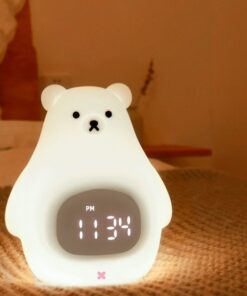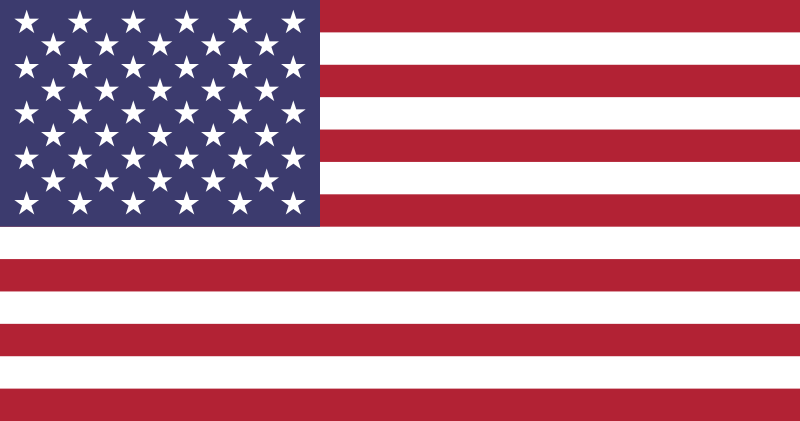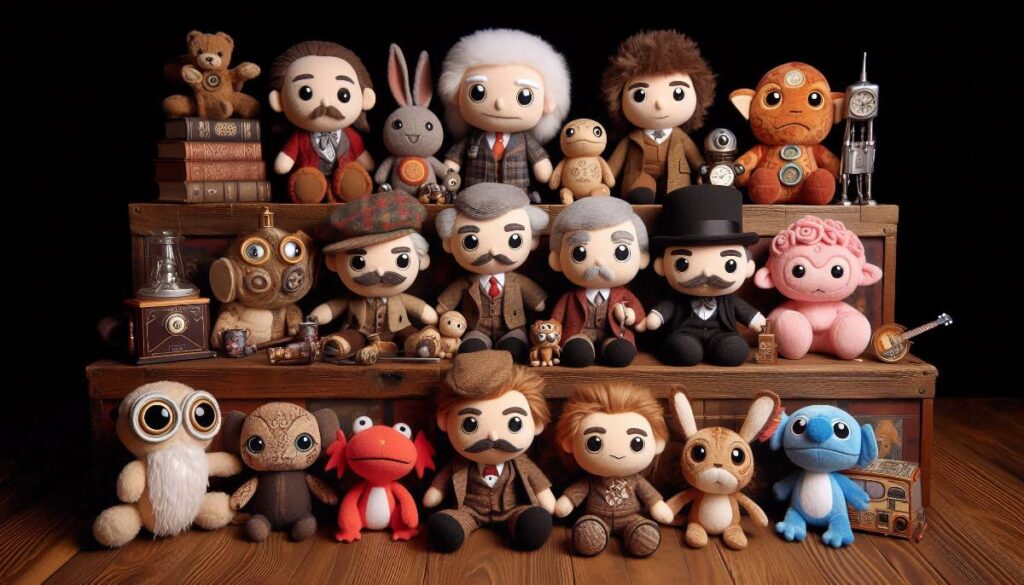-
×
 Polar Bear Alarm Clock And Night Light
Polar Bear Alarm Clock And Night Light
- Delivered in:
5-11 days
1 × $29.99
Plushies
Famous Plush Toy Makers: A Look at the History of Soft Toy Creators
Table of Contents
The History of Plush Toys – An Introduction
Plush toys have a long and storied past, evolving from simple hand-sewn objects to beloved companions and collector’s treasures. The journey began in the early 20th century with the creation of the first teddy bear—sparked by a political cartoon featuring U.S. President Theodore Roosevelt in 1902, which inspired both Morris Michtom in America and Richard Steiff in Germany to create the now-iconic bear (Bryant & Thompson, 2020). This innovation marked the beginning of a soft toy revolution, paving the way for plush animals, fantasy characters, and artisanal creations.
Over time, the history of plush toys has reflected changing materials, consumer preferences, and cultural influences. Early plush toys were crafted with mohair and stuffed with straw, but as manufacturing evolved, designers adopted synthetic fibers and polyester stuffing for improved softness, durability, and safety. The plush toy industry expanded throughout the 20th century, fueled by mass production, character licensing, and a growing appreciation for the emotional connection these toys offered.
Today, plush toys are more than just cuddly gifts — they are vessels of comfort, storytelling, and even artistic expression. Whether it’s a vintage-inspired teddy bear or a quirky modern design like a soft alpaca toy, plush toys continue to captivate across generations, offering something deeply nostalgic and emotionally resonant. For collectors, designers, and gift-givers alike, understanding the roots of these toys enhances their appeal, especially when seeking to buy plush toys online that reflect heritage and creativity.
The Legacy of Popular Brands
When discussing famous plush toy creators, it’s impossible not to mention iconic brands that have defined the industry. Companies like Steiff, GUND, Build-A-Bear Workshop, and Ty Inc. have become household names due to their consistent quality, emotional resonance, and creative designs. Steiff, founded in 1880 in Germany, was the first to manufacture teddy bears commercially and is still revered for its craftsmanship and collectability. Meanwhile, Ty revolutionized the market in the 1990s with Beanie Babies, introducing the idea of mass-market collectibles that also felt personal and endearing.
These brands have grown not only by offering comforting toys but by embracing character licensing, from Disney and Pokémon to Marvel superheroes. This diversification helped plush toys reach broader audiences, including adult collectors and pop culture fans. Consumers looking to buy plush toys online often turn to these recognizable names because of their reputation for quality, storytelling, and innovation.
At the same time, many unique plush toy brands have emerged with fresh, indie aesthetics that rival the giants in creativity and charm. Smaller studios and artists often produce limited-edition toys with distinctive personality—like hand-sewn panda plush toys for collectors or intricately detailed alpaca plushies. These alternatives provide excellent value and speak to a more personal, curated experience in toy buying.
The Legacy of Popular Brands
When discussing the history of plush toys, a few names inevitably rise to the surface due to their transformative influence on the industry. Brands like Steiff, Gund, and Ty Inc. have shaped global perceptions of what a soft toy can be. Each brand’s legacy is a combination of craftsmanship, innovation, and emotional resonance.
Steiff, for example, is often credited with inventing the teddy bear in 1902, after Richard Steiff designed a jointed bear inspired by real animals. The company’s commitment to high-quality mohair and meticulous hand-stitching set the benchmark for luxury plush toys Steiff Official. Meanwhile, Gund, founded in 1898, brought softness and durability to the American market, with innovations like understuffed plush to enhance cuddliness Gund History. In the 1990s, Ty Inc. revolutionized plush collecting with its Beanie Babies, transforming toys into investment items and introducing a new model of limited-edition marketing Smithsonian Magazine.
While these brands continue to thrive, it’s important to recognize that independent creators and small studios also produce plush toys with exceptional quality and charm. These often-overlooked makers offer unique storytelling, artisanal value, and the chance to own something truly distinctive. Whether you’re drawn to a panda plush toy for collectors or a soft alpaca toy from a niche designer, the plush toy world extends well beyond the mainstream.
The Artistry of Well-Known Creators
Behind many cherished plush toys lies the unique vision and craftsmanship of talented creators. These individuals—often artists, designers, or independent makers—infuse each toy with personality, story, and soul. Well-known names like Linda K. Williams, Yosiell Lorenzo, and Amanda Visell have cultivated distinct styles, turning plush toy design into an expressive art form. Their creations are often limited-edition or hand-finished, making them especially sought after by collectors and fans of designer toys. Many of these toys blur the line between art and plaything, with character-driven narratives and intricate features that elevate them beyond mass production (Wiles & Hart, 2021).
Take, for example, Yosiell Lorenzo’s gothic-inspired creatures or Amanda Visell’s quirky, modern animal designs—each carries a clear creative voice. Yet it’s not just the big names contributing to the artistry of the plush world. A thriving ecosystem of lesser-known but immensely talented creators also exist. Many of these emerging artists sell through platforms like Etsy, offering lovingly crafted pieces that rival the quality and charm of their more famous peers (Singer & Singer, 1990).
Soft alpaca toys and hand-stitched axolotl plushies from independent makers often feature unique textures, colors, and expressions that add a special touch. These pieces not only bring joy but reflect the artist’s personality and commitment to quality. Supporting independent creators also helps preserve the diversity and innovation within the plush toy landscape, ensuring it remains vibrant and imaginative for future generations (Nelson, 2022).
Shopping for Plush Toys from Top Brands
Shopping for plush toys today offers more variety and accessibility than ever before. Legacy brands such as Steiff — known for creating the original teddy bear — have earned global recognition for their attention to detail, durable materials, and high-quality craftsmanship (Steiff Official). Their historical influence set the standard for plush toys as treasured companions and collectible items.
While iconic names have paved the way, today’s plush toy landscape is more diverse than ever. Consumers now have the freedom to explore a wide spectrum of options, from classic teddy bears to imaginative designs like panda plush toys or quirky animal companions. Whether you’re buying for a child or a collector, the key is to choose thoughtfully: look for toys made from safe, hypoallergenic materials, and backed by trustworthy makers.
As consumer interest shifts toward ethically made and design-forward plush toys, many are turning to independent creators and boutique brands that prioritize quality over mass production (Sanders, 2022). These emerging names often offer originality and warmth that resonate with modern buyers seeking meaningful purchases.
For a curated selection of charming plush toys, including panda, chicken, and alpaca-themed designs, visit Tixymix.com — a one-stop destination for soft, whimsical gifts made with care.
Purchasing Plush Toys by Well-Known Creators
For collectors, enthusiasts, and those seeking an artistic touch, plush toys created by well-known designers offer something truly special. These toys often reflect the creator’s distinct aesthetic, creative philosophy, and meticulous craftsmanship. Designers like Linda K. Williams, Yosiell Lorenzo, and Amanda Visell are known for their imaginative characters and carefully crafted details that elevate soft toys into collectibles (Wiles & Hart, 2021). Their plush creations blur the line between plaything and artwork, making them highly sought-after in niche toy communities and among adult fans of plush toys.
While these creators often release limited-edition runs through art toy conventions or specialty boutiques, their influence is far-reaching. For example, plush figures made by Amanda Visell frequently explore whimsical, fantastical themes, while Yosiell Lorenzo’s melancholic yet heartwarming style has built a loyal fan base (Nelson, 2022). Investing in plush toys from these renowned artists can be more than just a sentimental purchase—it can also be a meaningful addition to a personal collection with cultural and artistic value.
For those eager to explore these creators’ works or discover emerging designers, platforms or curated marketplaces such as DesignerCon offer direct access to unique and collectible plush releases. These platforms showcase a range of exclusive plush toy collaborations and emerging voices in the art toy space. By supporting such creators, buyers contribute to a vibrant ecosystem of independent artistry while acquiring plush toys that are rich in story, texture, and individuality (Singer & Singer, 1990).
Conclusion
The world of plush toys is far more than a collection of cuddly companions—it’s a vibrant cultural landscape shaped by artists, innovators, and everyday creators alike. While popular names like Ty Inc. or Build-A-Bear have played an undeniable role in the evolution of soft toy design, many plush toys made by lesser-known creators also offer incredible value, artistic merit, and emotional impact. These toys serve as symbols of comfort, creativity, and personal expression—whether they’re panda plush toys for collectors or soft alpaca toys designed with love and care (Ginsburg, 2007).
By broadening your exploration beyond household names, you can discover truly special plush toys that tell a story or reflect the personality of their maker. Today’s plush toy scene includes a rich ecosystem of handmade artists, small-batch manufacturers, and independent toy studios that prioritize quality and uniqueness. Many of these creators sell directly through platforms like Etsy, making it easy for fans to support them and own something one-of-a-kind (Roberts, 2019).
Whether you’re looking to buy plush toys online, add to your collection, or simply learn more about the history of plush toys and their creators, there is a world of magic waiting to be explored. Embrace the diversity, support emerging talent, and celebrate the enduring charm of plush toys that continue to bring joy, nostalgia, and imagination to people of all ages (Brown, 2009).
References
Brown, S. (2009). Play: How It Shapes the Brain, Opens the Imagination, and Invigorates the Soul. Avery.
Bryant, J., & Thompson, S. (2020). Children and Media: The Role of Toys in Early Development. Springer.
Ginsburg, K. R. (2007). The importance of play in promoting healthy child development and maintaining strong parent-child bonds. Pediatrics, 119(1), 182–191.
GUND. (n.d.). About Us. Retrieved from https://www.gund.com/pages/about-us
Nelson, M. (2022). Character-based toys and their role in imaginative development. Journal of Play Studies, 14(2), 55–68.
Roberts, L. A. (2019). Designing Toys for Cognitive Growth: A Developmental Psychology Perspective. KidTech Press.
Sanders, L. (2022). From shelves to showcases: Plush toys as collector’s items. Journal of Popular Culture Studies, 9(4), 201–215.
Singer, D. G., & Singer, J. L. (1990). The House of Make-Believe: Children’s Play and the Developing Imagination. Harvard University Press.
Steiff Official. (n.d.). Our History. Retrieved from https://www.steiff.com/en-int/historyWiles, M., & Hart, L. (2021). The psychology of pretend play: Implications for educational toy design. Child Development Perspectives, 15(2), 88–94


